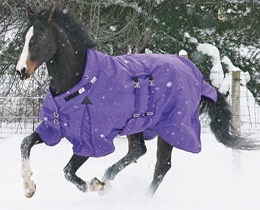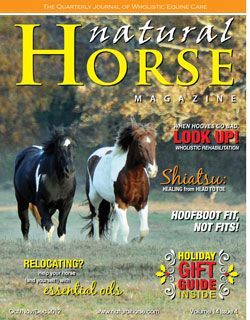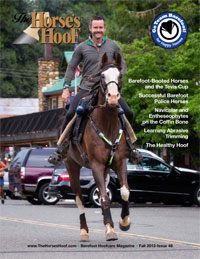Blanketing Q&A
By Sushil Dulai Wenholz • Oct 01, 2005 • Article #15542, thehorse.com
Crisp fall air signals a perennial dilemma for many horse owners: To blanket or not to blanket? And if you opt for the added cover-up, which blanket is best? Our five-point Q&A will help you make those decisions and more, so you can see your horse through this season and the frigid one ahead in comfort and good health.
Does my horse really need a winter blanket to stay warm when winter rolls around?
There is no simple answer, and Carrie Finno, DVM, of the University of Minnesota, recommends assessing each individual horse’s needs. Considering the factors below will help you do so.
Hair coat–A horse that grows a thick winter coat might not require any blanketing, says Finno. Cold weather causes your horse’s hairs to stand on end, which creates an insulating effect with warm air trapped near the skin. In fact, putting a blanket on a furry horse can reduce that insulating power by flattening the hairs. However, if your horse’s winter coat is skimpy or if you body-clip your horse, then a blanket might be necessary to make up for what’s missing.
Weather–Horses with full winter coats can stay warm, without blankets, in temperatures well below zero. “After living in Minnesota for five years, I have been impressed with how well horses manage in colder climates,” says Finno. “Our horses love to be out in the snow! Many owners do not blanket in the winter here, even with the extreme temperatures, and their horses do quite well.”
However, she adds, it’s also important to consider other weather factors, such as humidity, wind chill, and precipitation.
Of these, precipitation may be the biggest threat to your horse’s cold-weather comfort, says Liz Wilkinson, a horse clothing specialist for blanket manufacturer Weatherbeeta.
When soaked, even a thick winter coat can lose its warming power, leaving your horse chilled to the skin. Similarly, stiff winds can lift the hair coat, allowing icy blasts to penetrate straight to the horse’s skin. So, a horse that might be comfortable naked on a dry 20-degree day might appreciate a lightweight, waterproof cover if it’s windy or wet, even at a more moderate temperature.
Remember, too, that the notions of “hot” and “cold” are relative. A Florida horse accustomed to winter temperatures in the 60s will likely find 40 degrees chilly if he’s suddenly relocated to a colder climate. That horse might need a blanket even when his stablemates, accustomed to the local weather, might not.
Living arrangements–Your horse should always have shelter available, says Finno. That can reduce the impact of wet and windy days, making a blanket less necessary. But again, other factors come into play. For instance, a slick-coated show horse that lives in a stall would likely appreciate a blanket when turned out on a winter day, even if it’s dry. In fact, many stall-bound show horses wear blankets even in the barn.
Age and health–Foals and geriatric horses might have a tougher time keeping themselves warm than an animal in his prime, so a blanket might boost their comfort levels and help them stay healthy. Likewise, an ill horse will benefit from an extra coat while his immune defenses are low.
What type of blanket should I use to keep my horse nice and toasty?
If your horse will wear a blanket outdoors, your best bet is a turnout rug, whether he’ll be alone in a paddock for a couple of hours or living with a pasture herd 24/7. Turnout blankets are designed to withstand the rigors of outdoor wear and equine roughhousing. Most are also waterproof. Wilkinson says waterproof turnout blankets are the most prevalent style, and people often buy a single one for both indoor and outdoor use.
Stable blankets are designed for indoor use, so they’re usually less rugged and not waterproof. Stable blankets do have a couple of advantages for stalled horses, though. First, explains Wilkinson, they are physically lighter in weight, which means less pressure on your horse, and thus a lower incidence of rubbing. Plus, stable blankets tend to be less expensive than turnout rugs.
If your horse spends time indoors and out, and you have the budget for it, consider buying both a turnout and a stable blanket. If you can only afford one, then the more versatile turnout rug is probably the way to go.
Both stable blankets and turnout rugs typically come in three weights–light, medium, and heavy. Unfortunately, what’s considered light, medium, or heavy is determined by each manufacturer, so two midweight blankets don’t necessarily deliver the same warmth. Typically, though, a lightweight blanket has no insulating filler, a midweight cover has 200-300 grams of filler, and a heavyweight rug has 300 or more grams of filler.
Rather than having one of each weight, some people prefer to simply add a liner under the horse’s existing blanket when the temperature drops. Wilkinson advises this tactic only if you’re already using a heavyweight rug and still need more warmth. Otherwise, she recommends using a single blanket of the appropriate weight whenever possible.
“The more blankets you have on, the more likely they are to shift,” she explains. You’re also adding weight (a blanket liner weighs more than another hundred grams of filler) as well as additional straps, which can become restrictive.
What materials should I look for in a good winter blanket, for both the outer shell and fill/lining?
Most turnout blankets have an outer shell of nylon, polyester, or a combination of the two, says Wilkinson. A handful, she adds, are made of polypropylene. Stable blankets are often made with these same materials, but might also be made of cotton, cotton blends, or polar fleece.
Nylon is typically considered the high-end material, with 100% polyester at the lower end of the scale, says Wilkinson. “Nylon is very strong and resilient and it doesn’t hold stains, but it’s very expensive,” she says. “Polyester is lightweight, more affordable, and strong, but comparing strength per weight of material, it’s not as strong as nylon.” Often, she notes, using a blend gives you the best of both worlds–strength and durability, lighter weight and less expense.
The strength (and thus durability) of a blanket’s outer layer is expressed in terms of its denier (a unit of measurement for fineness); the higher the denier number, the stronger the material. However, adds Wilkinson, since higher-denier materials are also heavier, you should go only as high on the scale as your particular horse needs. This is where nylon can have an advantage over polyester, because it takes a 1,200-denier polyester to match the strength of only 840-denier nylon, she notes.
Finno says that she uses nothing less than 1,200 denier for turnout. But for indoor use on a horse that doesn’t tend to rip his rugs, you can probably get by with something in the range of 400 denier.
You’ll also see a selection of linings; polycotton, nylon, and fleece-like wicking material are the most common. Picking one, says Wilkinson, is a matter of personal preference. She prefers the wicking liner because it’s more breathable than the others.
“And the more breathable the liner, the more breathable the blanket,” she states. (We’ll explain breathability in a minute.)
Still, nylon is probably the most common lining. “It’s also breathable, and it’s slick, so hairs don’t get caught, and it keeps the coat shiny,” notes Wilkinson. Other people prefer less expensive polycotton (polyester and cotton), she adds, believing that it feels better to the horse. However, if polycotton gets wet or sweaty, it dries more slowly than nylon or wicking materials.
When selecting a blanket, also consider whether it’s waterproof (a must for turnout in wet weather) and breathable. Breathable blankets allow moisture near the horse’s skin to pass through to the surface. For instance, if your blanketed horse works up a sweat romping with his pals on a brisk winter day, a breathable blanket will help him stay at a comfortable temperature–and prevent chills–by allowing the sweat to escape into the air. Wilkinson explains that the breathability of turnout blankets is determined largely by a special coating applied to the underside of the fabric, although some manufacturers use a Gore-Tex membrane instead.
What design features should I look for in a blanket? Which are frills and which are really useful?
Today’s blankets boast a variety of special features and options designed to improve your horse’s freedom of movement and comfort while minimizing the blanket’s movement on your horse. Here are four areas where you’ll have choices to make.
Neck–“A standard neck is tried and true, but the biggest problem is that when it rains, water can run into the shoulder,” says Wilkinson. “If that’s a concern, move to a high neck. The front acts something like the brim of a ball cap and prevents water from running in. It also distributes (the blanket’s) weight so it doesn’t shift back on the horse, and it takes weight off the withers and shoulders.”
Cut-back necklines are also available; some people like them for high-withered horses because they allow the horse to move more freely and help to prevent rubs on top of these prominent withers.
Shoulder–Shoulder rubs and restricted shoulder movement are perhaps the most prevalent blanketing troubles. Shoulder gussets, now available on many blankets, can help with both issues by helping to alleviate pressure on the shoulders during movement. Other innovations that also might help include straps that cross at the horse’s chest and straps that allow you to adjust fit through the shoulders. However, Finno notes that advanced design attributes alone won’t always prevent hair loss over the shoulders, since the simple friction of the blanket moving across the coat can cause the problem. In that case, stretchy shoulder guards and other horse “underwear” can help.
Tail–In bad weather, horses turn their hind ends to the wind. A tail flap offers added protection for this exposure and helps keep the blanket sides down during wind gusts, says Wilkinson. Just make sure that the horse can still easily lift his tail despite the flap.
Front–Closed-front blankets aren’t as popular today as open-front styles. But which to choose depends on your preference and whether your horse will accept the closed-front blanket sliding over his eyes and ears every time you remove or replace the rug.
How much will I pay for a blanket, and how do I protect my investment?
There are almost as many prices as there are styles. On average, expect to spend $100-$250 for a turnout blanket and $50-$100 for a stable blanket, although you’ll see higher and lower prices. Higher denier materials, more insulation, and innovative features will raise the price.
To protect your investment, take good care of the blanket. Wilkinson advises regular inspections so you can catch and repair small problems–such as loose stitching and tears–before they grow. Keeping your blanket clean will also aid longevity. Use a stiff horse brush to remove dirt and hair from the blanket’s inner and outer surfaces. Wash the blanket periodically, following manufacturer instructions, which might recommend non-detergent blanket cleaners or the application of waterproofing agents after washing.
It’s Your Choice
The question of whether or not to blanket your horse doesn’t come with a simple answer. But by assessing your horse’s individual needs, the equine lodgings you have, and the weather patterns in your area, you can make a decision that will help your horse live through the chilly months in comfort and good health.
When To Blanket? Blanketing by Degrees
So you’ve decided to blanket your horse. But what should the thermometer read before you slap on that protective layer, and how low does the mercury need to dip before it’s time to upgrade to a warmer weight? Carrie Finno, DVM, of the University of Minnesota, shares her guidelines for two different scenarios. f
When in doubt, you’re usually better going lighter than heavier, because overheating tends to be the greater danger for horses. You can also do this quick check:
- Your horse is probably too cold if he’s shivering, seems unusually tense or stiff, has cold ears, or has hairs standing on end.
- Your horse is probably too warm in his blanket if he’s sweating (check the rib cage, not just the shoulder) or seems unusually restless.–Sushil Dulai Wenholz
|
BLANKETING GUIDELINES |
|||
|
PUT ON A |
WHEN THE TEMPERATURE REACHES |
||
|
|
HORSE WITH AVERAGE WINTER COAT |
BODY-CLIPPED HORSE |
|
|
Light sheet |
50°F |
65°F |
|
|
Midweight blanket |
45°F |
50°F |
|
|
Heavy blanket |
20°F |
40°F |
|
|
Heavy blanket and liner |
Below 0°F |
Below 30°F |
|












Please share with me if you blanket your horse and, if you do, why you do it. Please don t tell me it s for vanity purposes just so your horse won t look too hairy or because you want him slicked down all year.
I, personally, only blanket of the individual horse is needing it for whatever health reason. Otherwise my guys are au naturale 24/7, 365.
Much research says NOT to blanket..Dr. Hildrud Strasser explains why in her books…also..
BLANKETING INFORMATION posted by
Westwood Farms
Here is some information on winter blanketing that may surprise you. This is the result of a multi-year study done by CSU, using state of the art thermal detection equipment. Colorado State University is widely conside…red to be one of the top three equine veterinary schools in the country: Blanketing horses is one o
f the worst things that you can do to a horse in the winter. Horses have the ability to loft and lower their coats to 17 different levels, so it’s like exchanging 17 different thermal weights of blankets off and on them all day and night, depending on what they need- except that we don’t know what they need as well as they do. Their ‘self-blanketing’ process works a little like ‘chill bumps’ do in our own skin. That’s why long-haired horses may seem fluffier on some days than on others. Only three things make the ‘self-blanketing’ process not work: blanketing, clipping, …and wind. Not even sn
ow or rain stops their own thermostats from doing the job. Also horses are in ‘neutral’ (meaning not using energy for either heating or cooling) when the air around them is between 26 and 38 degrees. Otherwise, they’re using energy to control their temps. So- since they’re cooling their bodies when the temp is over 38 degrees, they’re having to use extra energy to cool themselves when blanketed in temperatures over that. Any time a horse that is outside and has a long coat is shivering, it’s because the horse has opted to shiver to warm itself, instead of using the option of moving. Moving generates a considerable amount of heat for a horse, but they sometimes stand and shiver while napping, etc. It does not mean that they need to be blanketed. However, a horse MUST have a way to get out of the wind in order for their self-blanketing’ abilities to function fully. It turns out that blanketing is done more for pleasing the human, than to fill a need of the horse. The horse blanket industry has done a great job of making us think that their product is a necessary part of good horsekeeping, when it is actually an item that is very seldom needed